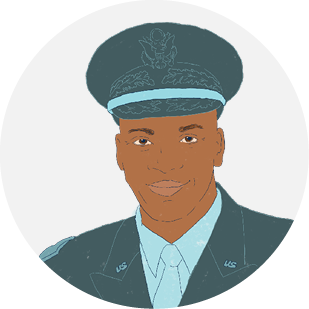I feel like I had enough time, I just didn’t know what to do. That's the difficult part about transitioning out: no one in the military has transitioned out, so there isn't someone that can explain how to do it.
Where we are
Each year, approximately 200,000 Service members leave the military and must reorient their lives. This includes fundamentals like their employment and education, finances, housing, health, and even relationships.
Existing research shows that navigating the military transition can be burdensome and confusing for Veterans, their families, and their supporters. While progress has been made, data suggests that around half of all recently separated Veterans don't connect with available resources and benefits for several years, and sometimes only when they are in crisis. Improving military-to-civilian transition can serve as early intervention to downstream challenges with Veteran homelessness, suicide, health, unemployment and underemployment, and poverty. Addressing these challenges can have lasting ripple effects on a community of approximately 43 million Veterans, family members, survivors, and caregivers.

Our approach
To start, we listened to people’s stories.
The Life Experience research team spoke with Service members, Veterans, and other military-connected people nationwide about this moment in their lives and where the government process could have been simpler and more helpful. The listening sessions captured honest conversations about peoples' experiences, candid feedback on what could have worked better, and what really made a difference for them. Their stories have been combined and are represented here through illustrations. The quotes are real, but names have been changed.












Overall, the team spoke with 200 people through interviews as well as site visits to military installations.
The team spoke with:
- 50 recently separated Veterans
- 71 transitioning Service members
- 10 family members
- 69 individuals from the Department of Defense, Department of Labor, Department of Veterans Affairs, and community subject matter experts
Discovery insights
Framing for collective thinking about customer pain points
How might we provide a transparent transition process that focuses on the future success of the transitioning Service member?
How might we help transitioning Service members approach social reintegration in a genuine and dedicated way before and after separation?
How might we provide relevant and high-quality individualized guidance and clear instructions available throughout the transition process?
How might we consider opportunities to improve existing military resources that ease the Service members’ reintegration post-separation?
Design Phase
Designing customer-centered solutions
View progress on our milestonesIn the 2024 design phase, the team plans to build and pilot a digital minimum viable product (MVP) that aims to simplify and personalize transition planning and enhance access to resources for Service members, Veterans, and their families.
The project aims to develop a new digital solution tailored to Service members, Veterans, and their families. This solution will offer comprehensive, personalized, and integrated information on various aspects of military transition, such as education and skills, employment and career opportunities, family and community integration, financial planning, health and well-being, and housing options from across agencies. The digital tool will have personalization according to each Service member’s, Veteran’s, or family member’s potential life goals, career paths, duration of service, and anticipated separation date.
The development process will involve creating a Minimum Viable Product (MVP) through iterative phases and actively engaging with Service members and Veterans for feedback. Alongside the digital solution, implementation, and promotional materials will be developed to ensure it reaches its intended end-users and effectively addresses Service members’ and Veterans’ unique needs and circumstances during their transition from service.
Project objectives
Simplify and clarify the transition planning process by contextualizing resources into the goals Service members and families set when separating.
By enhancing the completeness and accessibility of crucial information, this project seeks to empower Service members, Veterans, and their families to plan and make informed decisions about their military transition. It will enable them to engage with resources and benefits from across agencies that best align with their personal goals and action plans. Additionally, it will support them during pivotal moments in their journey, ensuring a smoother transition to life after military service.
Updates
The project addressed a core challenge identified during discovery research: transitioning service members often face significant barriers in accessing clear, personalized guidance for life after the military. Key areas of need include civilian employment, VA claims, and healthcare services. To address this challenge, the team developed a digital solution designed to simplify the transition process through curated pathways. In 2024, the team piloted and released a soft-launch “Minimum Viable Product” digital solution on VA.gov. The solution was shaped through extensive co-design sessions and cross-agency collaboration, ensuring that each iteration is informed by the validated needs of transitioning service members and military families. The team is currently completing co-design iterations for Version 2 and securing buy-in from DoD partners to continue additional pilots.
See the 2024 project evaluation plan to learn about the project measures and methods.
The team initiated the project focusing on four areas: navigating the transition process; planning for life after the military; right-sizing and timing curriculum content; and selecting, organizing, and presenting personalized resource connections. The team coordinated with representatives from nine Federal agencies and five military service branches on three HCD improvement sprints.
Sprint 1A involved co-designing with customers to develop a digital solution that consolidates action steps from multiple agencies and delivers the right information and resources at the right time.
Sprint 1B investigated technical feasibility in response to customer-relayed usability and design considerations. The sprint included gathering requirements to provide recommendations to inform project resourcing, piloting, and communicating with customers.
The Transition Assistance Program (TAP) provides information, resources, and tools to Service members and their loved ones to help prepare for the transition to civilian life. The TAP Executive Committee, which provides cross-agency shared governance over the program, approved all of the HCD-rooted recommendations, green-lighting the proposed solution for MVP development.
Sprint 1C recently launched and seeks to develop solutions for customers to receive information and resources earlier in their military careers with clear calls to action. Recognizing that TAP is in part overseen by commanders, cross-agency partners rallied around a visual management solution to make TAP progress more transparent within chains of command and supporting organizations—to promote proactive engagement and external accountability. This sprint will deliver prototypes and recommendations in the first quarter of FY 2024.
Measures of success
Key outcomes:
In 2023, gain cross-agency concurrence to develop and build the MVP digital product. The long-term outcome of this solution aims for an increase in the number of Service members who feel prepared for their transition.
Design phase project measures:
Project Documentation
- Portfolio Charter
- Portfolio Summary
- Design Project Summary: Prototyping Integrated Transition Planning for Service Members
- Customer Journey Map & Stories
- Information collection approved under OMB Control #2900-0876
- Life Experience Initiative Summary
- Executive Order 14058
- President’s Management Agenda
Project Outputs
Agency collaborators
- General Services Administration (GSA)
- Department of Labor (DOL)
- Department of Housing and Urban Development (HUD)
- Office of Management and Budget (OMB)
- Department of Education (ED)
- Department of Defense (DOD)
- Department of Veterans Affairs (VA)
- Office of Personnel Management (OPM)
- Small Business Administration (SBA)
